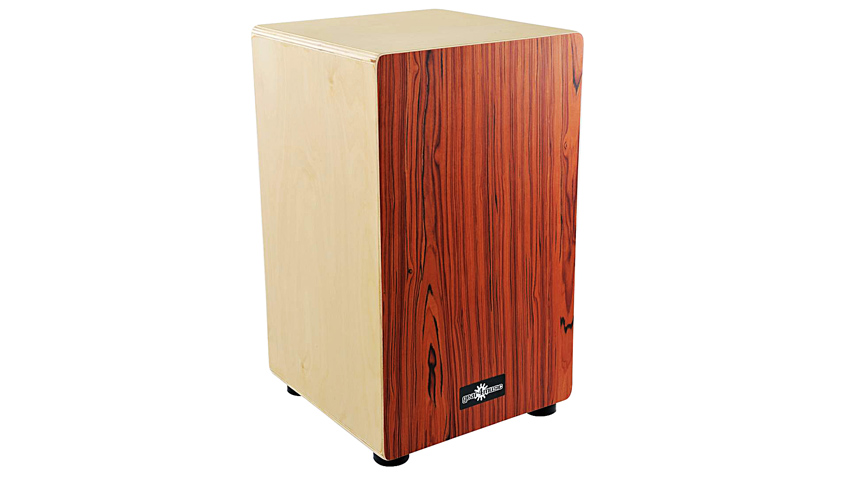MusicRadar Verdict
The Gear4Music cajon is a great way of trying out this incredibly versatile instrument. This model is impressive, especially considering the price and the included carry case too. A great deal.
Pros
- +
Very portable, great sounds, great price.
Cons
- -
You can't engage or disengage the snare sounds while playing.
MusicRadar's got your back
The cajon - prounounced 'ka-hon' - can trace its roots back to Peru. Once associated purely with Afro-Cuban, Latin, and flamenco music, this percussion instrument has found its way into a whole range of musical styles and genres, primarily due to its portability, versatility and sound.
The cajon is sometimes known as a drum kit in a box and anyone coming from a kit background will appreciate the many advantages of owning a cajon. Most obviously, it will fit into a much smaller space than a drum kit. Its relatively small size means it's much easier to transport from gig to gig and, once at a venue, there's no time-consuming set-up; it's ready to go. Plus, with a cajon, you're much more likely to get invited to an unplugged jam night.
Build
Like most cajones, this one consists of a rectangular-shaped box constructed from wood. It is formed from panels of plywood that vary in thickness according to their location; the top and bottom sections are the thickest, with a six-ply construction, whereas the sides are a much thinner three-ply. The thinnest of them all is the front panel, or 'tapa', which is a slender slice of wood, finished in a rosewood-effect veneer. Overall the natural exterior finish is really good, with a smooth feel and no sharp edges.
About a third of the way down the rear panel is a 12cm sound hole which is large enough to afford a good peak inside. Towards the front and stretching from top to bottom is the sound post, which sits around 20mm away from the tapa. All of the panels are butt-jointed and glued together using white wood adhesive. Where necessary - and where it won't affect the overall sound - the cajon is strengthened by pieces of wood glued to the inside.
Directly up against the inside of the tapa is a series of wires and tiny sleigh bells which, when the front is struck, provide sounds similar to a snare drum and other types of drum. These 'snares' may be tightened or loosened by two small hex screws located under the base of the cajon. Gear4Music has provided a hex key which is located just inside the lower part of the sound hole. As making the adjustment involves up-ending the cajon, this is really only practical when taking a break and not mid-performance.
Included with the Gear4Music cajon is a small neoprene mat, about the same size as a large mouse mat. It's for you to put on top of the box and sit on, and should hopefully stop you sliding off mid-flow. It's far too thin to be comfy, but you could always use your own small cushion.
Also included is an excellent protective carrying case. It has adjustable straps that you can wear over your shoulders backpack-style, or you can carry it in one hand using the handle on the top of the case.
Want all the hottest music and gear news, reviews, deals, features and more, direct to your inbox? Sign up here.
Hands on
The tapa is the area which usually gets struck - either with a slap of the hand, the whole palm, a light tap with the fingers or a combination of all three. You can also move your foot up and down the tapa while playing with your hands. This raises and lowers the pitch of the instrument depending on whether you're moving up or down, and can also dampen the sound, making it more thuddy. You can also play the cajon with brushes or birch rods and these add a whole new dimension to the sound this Gear4Music box is capable of.
Towards the top of the box, the overall sound is much like a bongo. Move down slightly and the cajon suddenly sounds like a dampened conga. Straight, rocky beats are easy to achieve with the snare-like qualities of the upper- to mid section, while you'll get a bass drum sound - mixed with the pleasant background buzz from wires - if you head down to the lower to mid section and strike there. Latin rhythms are easy to conjure from this magic box; a mambo, a beguine or even a cha-cha all sound surprisingly authentic.
MusicRadar is the internet's most popular website for music-makers of all kinds, be they guitarists, drummers, keyboard players, DJs or producers.
GEAR: We help musicians find the best gear with top-ranking gear round-ups and high-quality, authoritative reviews by a wide team of highly experienced experts.
TIPS: We also provide tuition, from bite-sized tips to advanced work-outs and guidance from recognised musicians and stars.
STARS: We talk to artists and musicians about their creative processes, digging deep into the nuts and bolts of their gear and technique. We give fans an insight into the actual craft of music-making that no other music website can.

